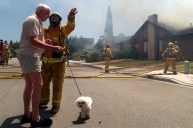Getting your family ready to evacuate in an emergency can feel like a huge process. But don't forget Fido!
Evacuating during a natural disaster can feel pretty hectic for families. Pet owners have one more family members to worry about while they get everyone loaded into the car, including their four-legged companions. Some pets may be easier to load into the car than others — Small animals can get picked up and put in the car in their regular cages or picked up and put into a smaller cage. However, transporting pets in an emergency can be rather difficult, especially with larger animals, like cats and dogs, which can be hard to get into a pet carrier.
Preparing to Evacuate Pets
Don't forget to include pets in your evacuation plan. Pack these items in your go-bag:
? Food, water & bowls
? ID tag, leash & toys
? Meds & copies of medical records
? Photo of yourself with your pethttps://t.co/4ARIZS7wds#Ida pic.twitter.com/yQEeOQmbCH— Readygov (@Readygov) August 28, 2021
RELATED: Traveling With Service Dogs? Tips for Flying, Driving, and More
While pet owners hope never to have to evacuate in an emergency, it is always good to have a plan in place. Depending on where you live, a natural disaster can hit at any time. Wildfires, floods, tornadoes, hurricanes, and earthquakes are unpredictable emergencies that can give you little warning. However, there are a few steps you can take for disaster preparedness.
Have An Emergency Plan In Place.
If you live in an area prone to natural disasters, make sure you have a disaster plan in place. Have a list of what you need to grab, and make sure you have easy accessibility to your important documents and emergency supplies. In addition, make sure you include your pets in your evacuation plan. PG&E suggests that you have these items prepped in an emergency kit for your pets:
- Food for a week
- About a gallon of water
- Vaccination and medical records
- Pet medications or prescriptions
- Pet kennel
- A picture of you and your pet
- Phone numbers of friends and pet-friendly hotels
- Contact information for your pet's vet and local animal hospital
- Identification for your pet
- Pet first aid kit
Also, be sure your pet's microchip has your current cell phone number. If you are sheltering in a safe place and get separated from your pet, your home number won't be useful if someone tries to contact you.
If you find yourself in an emergency situation, you never know what you may need, but this helps start you off on the right foot as you prepare to evacuate your home.
Leaving Your Home
Practice makes purr-fect! Practice evacuating & sheltering in place to prepare your pet for an #emergency. More ways to prep your pets: https://t.co/vrIkFKBC1C #PrepYourHealth #PetPreparedness #Caturday pic.twitter.com/8uMsnjE2JW
— CDC Emergency (@CDCemergency) June 29, 2019
When you get the alert from emergency services or a knock on the door that it's time to leave, you may only have several minutes to grab the basics. For example, you may not have time to grab a kennel or pet carrier, or you may not have one. How do you keep your pet safe if you do not have a carrier? Transporting your pet can become a lot more difficult in these cases.
According to the Humane Society, dogs can easily go in the back of the car with a leash, secured with a pet seatbelt or pet car seat. Cats are a little more difficult; if they have a harness, you can use that, or you can use a duffle bag if it is the only thing you have, and you know your cat will sit still inside. (Just make sure you leave the top unzipped!) In extreme situations, pet owners have also been known to use a pillowcase or a basket to transport their cats. Remember to make sure your window locks are on. Pets can get scared and accidentally open the windows while evacuating. If they are not secured or slip their harness, they can get seriously injured if they jump out of the car.
When you leave your home, you will likely head to an emergency shelter that may be outside of the immediate area. Some of these temporary shelters do not allow pets to come with you unless they are service animals. Therefore, your pet may need to go to a local animal shelter for the night or to a pet rescue, especially if you cannot get into a pet-friendly hotel.
Per the CDC, you can also contact your local emergency management services to see where pet owners can go where they will not be separated from their pets.
If you have larger pets, like horses or other farm animals, you may need to board them at an equestrian facility, or your local fairgrounds may open up their horse stalls for emergency use, and their lots may also be open for parking horse trailers. If you are concerned about how transporting your pets in an emergency may go, you can always practice so you and your furry friend can get the hang of it.
What To Do If Your Pet Needs Veterinary Care
Nothing is more stressful during an evacuation than your pet needing veterinary care. If you find yourself in the middle of a pet emergency while evacuating, you can administer basic pet first aid while you look for emergency pet care at a veterinary clinic or veterinary hospital outside of the evacuation zone.
Depending on the animal emergency, your injured pet may need to spend the night at the facility; the vets there will give you status updates on your pet to help ease your mind. Also, make sure they have your cell phone number so they can get ahold of you since you will not be at your home.
Have you had to evacuate with your pet? Tell us about it on our Wide Open Pets Facebook page.




